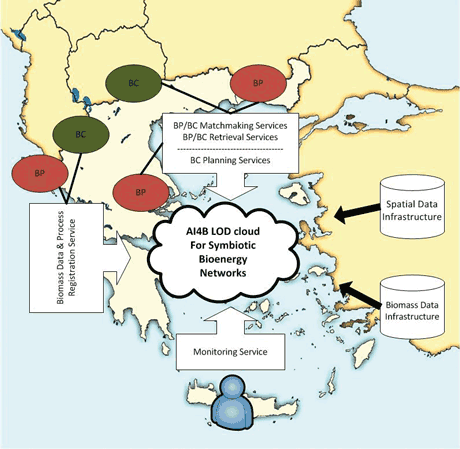by Theodore Dalamagas and Antonis Kokossis
Project AI4B aims to develop a data-driven approach to establish bioenergy networks of biomass feedstock producers and collectors, aiming to remove bottlenecks in the biomass supply pipeline and develop accountable, economically and environmentally sustainable bioenergy practices.
Biomass - biological material from living or recently living organisms - represents the largest renewable energy source and is the only renewable energy source that is based on carbon. Raw materials, such as wood, agricultural residues, food waste, industrial waste and co-products have captured the interest of markets and industries worldwide following the uncertainties in fossil fuel supply and the need to reduce greenhouse gas emissions. Involvement in the biomass business in Greece has several advantages, since Greece reports an agricultural share of the GDP that is three times higher than the EU average, and thus there are plenty of sources for raw biomass materials.
The AI4B project, co-financed by EU’s Regional Development Fund and by national resources, comes at a critical stage for the country, in line with a major effort to develop renewable energy sources, which is planned to be one of the driving forces to turn recession into growth. AI4B mobilizes academic partners, IT SMEs and regional development agencies to develop innovative IT infrastructures to remove existing bottlenecks in the biomass supply pipeline, and develop economically and environmentally sustainable bioenergy practices [1]. In AI4B, we focus on symbiotic bioenergy networks. “Symbiotic networks” [2] is an innovative environmental practice that brings together companies from all business sectors through material trading and sharing assets to add value, reduce costs and benefit the environment.
We focus on symbiotic networks with biomass supply chains involving biomass producers (BP) and biomass collectors (BC). BPs are regional players that provide storage points or production facilities. BCs are industrial players that collect biomass from BPs and employ valorization technologies for energy production. Our vision is twofold:
- To set up ΙΤ infrastructures to support “networking” between BPs and BCs by providing intelligent matchmaking and retrieval services.
- To leverage societal interaction and participation as an intrinsic part of the network by giving every citizen or public administration access to supply chain data.

Figure 1: Overview of the AI4B infrastructure
A data-driven symbiotic network
We follow a data-driven approach to maintain biomass symbiotic networks. BPs register on the network and provide information about biomass feedstock, for example: type, quantity and location of production. BCs also register and provide information about available biomass processing options and supply requirements. We will adopt the Linked Open Data (LOD) paradigm to set up biomass data infrastructures (BDI) for BPs and BCs. The LOD paradigm involves practices to publish, share, and connect data on the Web. “Linked”, means that data are interlinked under diachronic naming schemes, so that anyone can easily combine them and extract knowledge in multiple ways. “Open”, means that data are fully disclosed under open formats, open licenses, and machine readable formats. AI4B will set up a LOD base providing matchmaking and retrieval services so that BCs are able to identify BPs (and vice versa) according to their supply/production requirements.
Regional development and planning
The dispersed geographical distribution of biomass raises difficulties for the estimation of biomass quantities, the evaluation of technological pathways for biomass energy and the determination of the final cost for BCs. BCs need to explore several alternative delivery models to determine cost-effective biomass supply chains, and to identify the geographic distribution of the economically exploited biomass potential. Spatial planning can assist biomass logistics, and provides a means for exploring and evaluating alternative scenarios of biomass supply chains (characteristics, transportation cost, selection/sizing/costing of biomass production site) to determine optimal configurations. Key components in such an infrastructure are: (a) processing technology models that predict the output of biomass-related process blocks (eg the entire biodiesel process that converts biomass and fossil into new products) given input information (eg material and energy streams), (b) performance models that evaluate the economical performance, energy consumption, and greenhouse gas emissions, and (c) logistic models that address logistics and supply chain considerations. AI4B will provide services to set up cost-effective biomass supply chains, and explore alternatives in biomass processing and supply chain configurations based on what-if analysis tools.
Accountability in biomass symbiotic networks
AI4B will adopt the LOD paradigm to expose: (a) currently available spatial data infrastructures (SDI) as geoLOD data, and (b) process, performance and logistic models as biomass LOD data. LOD is considered worldwide as a driving force to provide transparent and accountable processes. In AI4B, all stages of biomass supply chains will be transparent. Every citizen or public body will have access to supply chain data, and be able to query decisions and demand ramifications.
The AI4B project is just about to start, and involves the following partners: Athena Research Center, National Techn. University of Athens, Centre for Renewable Energy Sources, Eratosthenes SA, CLMS Ltd, Tero Ltd, Kenakap SA, Aenol SA.
Acknowledgements: The authors acknowledge Dr. Ioanna Papamichael, Nontas Tsakonas, Dr. Yannis Zorgios, Stratos Arampatzis, Panayiotis Patras, Sevasti Basdeki for their contribution in this work.
Links:
http://en.wikipedia.org/wiki/Industrial_symbiosis
http://linkeddata.org
http://www.esymbiosis.gr
http://www.cres.gr/kape/energeia_politis/energeia_politis_biomass_uk.htm
References:
[1] G. Grant et al: “Information and Communication Technologies for Industrial Symbiosis”, Journal of Industrial Ecology, 10(5), 2010
[2] R. Isenmann, K. Chernykh: “The role of ICT in Industrial Symbiosis Projects. Environmental Informatics and Industrial Environmental Protection: Concepts, Methods and Tools”, 2009.
Please contact:
Theodore Dalamagas
Athena Research Center, Greece
E-mail:
Antonis Kokossis
National Technical University of Athens, Greece
E-mail:











